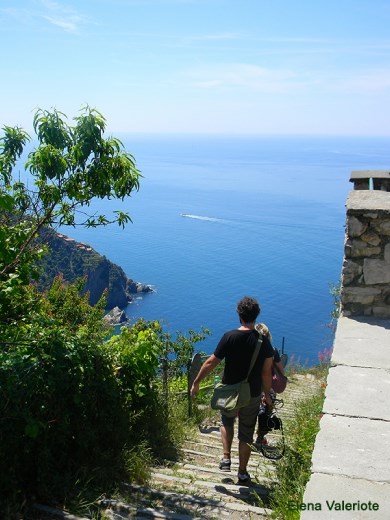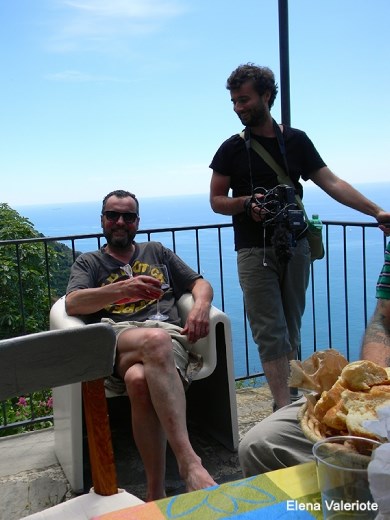My life whole I have wanted to come down the stairs of an airport escalator and be greeted by someone holding a paper with my name printed on it. It seemed to me that this was the epitome of glamour, the indication of an exciting adventure. Yesterday, I found this out to be true. I met my Cinque Terre guide Marzia and her colleague Silvia at the airport in Genoa. I couldn't imagine a better set of people than Marzia, Silvia and the other Parco Natzionale delle Cinque Terre representatives to introduce me to Cinque Terre. Their love for the region is not only obvious, but also contagious.

My story begins in earnest in Manarola, which is to be my home for the next ten days. The town seems to consist of one main street with the typical rectangular houses bunched together and painted in various shades of pink and orange that I’ve seen on so many “Bucket List” Pinterest boards and tourism photography books.

Marzia knows everyone here and we are warmly welcomed wherever we go. Last night a large group of us dined at da Aristide, a small restaurant near the sea, which offers many Cinque Terre specialties. Our meal tasted of the ocean in the best possible way. Everything was fresh and prepared with a few, simple ingredients. Marzia told us that this is the food of the poor (called so because of its simplicity) but it seemed like a dinner for kings.
Upon first being seated, the conversation turned to the most serious matter at hand – which wine should we begin with? No menu was consulted, but opinions were given, suggestions made and eventually the waiter hurried off to bring us a bottle of a local white wine, Costa da Posa.
The meal began with several types of mussels - one bathed in flavorful tomato sauce; another was elegantly undressed, accompanied by only lemon slices. Anchovies followed, also prepared in many different ways. A plate of lavender-colored squid and a seafood salad came next; then the pastas: spaghetti with pesto, tagliatelle with seafood and spinach ravioli.
The waiter came out and presented us with a plate of raw, pink fish. Everyone nodded their heads and he left. I had not seen this customary exchange before, but Marzia claims it is common for diners to approve their fish before it is cooked. The fish reappeared at our table shortly after, now white and buttery.
Throughout the meal, the wine bottles were constantly replaced, always with a Ligurian wine. Each was crisp and white, but made distinctly different by floral notes, a citrus scent or some flavor redolent of the sea. After many courses and much indulgence, the waiter brought limoncino and espresso. Close to midnight, we were the last people to leave the restaurant.
Almost everyone imagines that the Italians are marathon eaters. In my college textbooks for my Italian courses there are charts for explaining the proper order: Apertivo (light drinks such as a Spritz or Proseco), Antipasti (starter plates with small servings), Primi (usually pasta, maybe risotto or soup), Secondi (meats and fish), Contorni (sides, salads and vegetables), Formaggi e Frutta (cheeses and fruit), Dolce (something sweet, a typical dessert), Caffè (an espresso) and a Digestivo (liquor). From my first true Italian dining experience, it seems I didn’t learn all these terms in vain… Yet, the books (and the stereotypes) never explained the difference between the way Italians and Americans eat. The portions of food are smaller, the time of consumption prolonged, the ideology based on sharing.
I could get used to this.


Today everyone from dinner last night rejoined to hike up the hills around Manarola, making our way to the house of Marzia’s friend GiGi, who, like several of Marzia’s other acquaintances, owns a small vineyard and presses his own wine. The steps to his house formed steep, narrow trails of winding flat rocks, but the view from his porch was well worth the climb. We sat down to lunch at a table on his patio with a wide expanse of the Mediterranean ocean and the other hillside homes in sight. Our meal consisted of sopressa, prosciutto, peppercini, focaccia, eggplant, cherries and red wine. At the end, we were given a very special treat – the opportunity to try a few bottles of homemade sciacettra, a dessert white wine that is unique to the region. It was sweet, but not overwhelmingly so. Above all, I enjoyed hearing them proudly explain their wine production process and later show me their cellars. Unfortunately Gigi’s cantina (the Italian name for wine cellar) was filled with only wooden barrels and glass jugs. The season for the vendemmia (the grape harvest) isn’t until autumn.


In the evening Seth, the filmmaker for the project, and I dined at the Trattoria da Billy. It was nearly 9:00, a time when the average Italian dinner is in full swing, so we had to wait several minutes for a table to open up, but we were amicably handed a glass of prosecco upon walking in and the time passed easily. Before I knew it, the antipasti was being set before us – in order to accommodate the impressive twelve plate seafood starter, a second small table had to be set up next to ours. Pink tuna tartar, anchovies in oil, croquettes in orange sauce, fried squid… a beautiful array of colors, textures and flavors. I wouldn’t have imagined I could still have room for my main dish afterward, but when Billy himself presented me with a magnificent, silver fish surrounded by roasted tomatoes and potatoes, I decided to channel my the American and eat it all.

Billy set the plate down and expertly deboned the fish for me. With just a few swift movements, the fish veritably melted into a puddle of soft white flesh. The waiters, always perfectly able to move a dinner along by a change of drinks, removed our empty wine glasses and replaced them with smaller ones of Grappa.
Be it the food or the jet lag but my mind and body were in two different places. I had the urge to wander the streets of Manarola in the dark, not wanting to waste a second of my time here, but ultimately my exhausted limbs made the decision to head towards home.